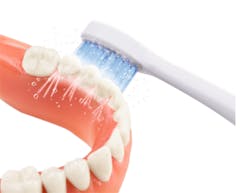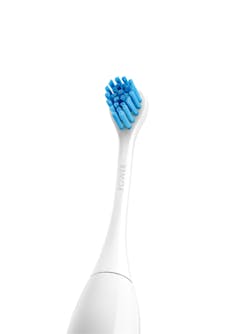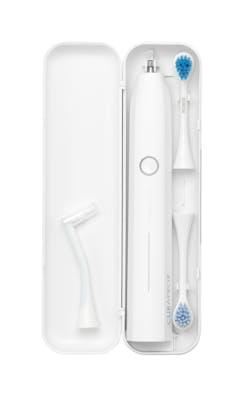The remarkable evolution of power brushing: New Swiss innovations
Sixty years ago, my grandmother took one step that led her to keeping her teeth for a lifetime. She started using a power toothbrush.
When I was little, my grandmother was diagnosed with periodontal disease. Her dentist had an upscale office on the famed Country Club Plaza in Kansas City, Missouri. He recommended full-mouth extractions and dentures. My grandmother had watched my grandfather struggle after he lost all of his teeth due in large part to a huge love of soft drinks.
My grandmother balked at the mere thought of losing her teeth. She was determined that there was another way, so she immediately sought a second opinion from a dentist who lived in her neighborhood. Dr. Robert Hite was a curmudgeon. His tiny office was on the 16th floor of the Professional Building in downtown Kansas City, the first building in the city whose renters had to be physicians or dentists.
Dr. Hite had only one treatment room, and it was equipped with a big black Weber dental unit that had a belt-driven slow-speed handpiece. Water swirled all day long in the porcelain cuspidor, and the headrest on the black patient chair looked like Mickey Mouse ears. The dental office perpetually smelled like rubbing alcohol and cloves. Dr. Hite was a one-man band. He did everything from scaling, to handwritten bills, to placing amalgam restorations.
By the time my grandmother sought his advice, Dr. Hite had practiced for more than 40 years. He had seen a lot, and his treatment plan for her was simple but comprehensive. He recommended that my grandmother have her teeth scaled every three months, suggested that she quit smoking, and encouraged her to use a tooth powder called Vince, an old-timey dentifrice that released high levels of oxygen when used as a paste or a rinse. My grandmother immediately took his recommendations to heart. She stuck with the plan for the rest of her life.
Despite his no-nonsense approach, Dr. Hite was decades ahead of his time. Today, there are a plethora of studies demonstrating the value of regular professional appointments, quitting smoking, and oxygen reducing the level of anaerobic periodontal pathogens. But 60 years ago, my grandmother took one additional step that led her to keeping her teeth for a lifetime. She started using a power toothbrush.
Powering up
The first modern electric toothbrush, called the Broxodent, was invented in Switzerland by Philippe-Guy Woog, PhD, in 1954, and was subsequently launched in the US market in 1959 at the American Dental Association meeting.1,2 My grandfather loved gadgets and technology. In 1960 he purchased the Broxodent electric brush for my grandmother. The following Christmas, my grandparents gave our young family a Broxodent. The curly cord at the end of the handle plugged into a wall socket, and when activated, the brush head moved from side to side, mimicking a hand brushing stroke. As a kid, I found technology fascinating, just like my grandfather, and today, my fascination and curiosity are bigger than ever.
The evolution of power brushing has been remarkable. The original brushes were heavy, posed an electrical hazard, and certainly did not have modern technological advancements. The value of a well-designed power brush is undisputed today. When used correctly, power brushes help create and maintain higher levels of oral health.3
Efficiency of fluid dynamics
The Swiss company Curaprox has been a leader in designing effective and innovative personal oral hygiene devices for half a century. Just as in 1954, the Swiss are continuing to create advancements in oral hygiene technology. The new Curaprox Hydrosonic Pro is setting a new benchmark in the power brush arena. The movement of advanced ultrathin filaments, housed in a unique brush head design, is based on ultrasonic vibrations.
From a clinician’s perspective, it is important to evaluate any product from top to bottom. Devices need to be efficient, effective, and easy to use. The Hydrosonic Pro brush employs fluid dynamics to disrupt plaque biofilm.4 The force of fluid in motion has the capacity to disrupt and remove the sticky organic bioburden on a microscopic level. The filaments in the brush vibrate back and forth. This movement propels the slurry of saliva, water, and toothpaste across tooth surfaces at a high rate of speed. The fluid mixture effectively disrupts biofilm in interproximal spaces, in areas with complex anatomy, and on easy-to-access surfaces (figure 1).
From a physics standpoint, how the toothbrush creates fluid movement is analogous to the movement of an ultrasonic scaler tip. Just like a power scaler tip, it is important to position the brush head on the tooth surface and use a light touch. Any pressure dampens bristle movement and reduces the effectiveness of the fluid dynamics. Light contact sets the stage for optimal debridement.
Effective designs and new innovations
In 1938, DuPont introduced the first synthetic toothbrush bristles.1 Since that time, the majority of all manual and power brush heads have been fabricated with nylon bristles. However, nylon retains moisture and does not dry out quickly. This can promote bacterial growth.
Curaprox brush heads use Curen polyester filaments, which are 0.10 mm in diameter. Polyester is a hydrophobic material. The filaments absorb very little moisture and therefore dry out faster, a benefit that retards bacterial buildup. Since a polyester filament is much thinner than a nylon bristle, Curaprox brush heads average three to five times the number of bristles found in a nylon brush. This thin, but densely packed, design results in a surface texture reminiscent of a finely woven, soft silk fabric.
While the polyester filaments are soft, they are also quite resilient, and they maintain their shape and springiness even when subjected to vibrations operating in a range of 22,000 to 42,000 motions per minute. Effective debridement is the goal of a good power brush. Since the filaments retain a uniform shape even when wet, the Hydrosonic Pro can deliver optimal and consistent fluid turbulence that disrupts biofilm across multiple complex tooth surfaces. The effectiveness of a manual brush is limited to touching the actual surface. When the user applies light pressure and a repetitive circular motion, the design of the power brush efficiently dislodges biofilm on all accessible surfaces.
The Hydrosonic Pro brush head features a bilevel filament arrangement that increases the effectiveness of the fluid dynamics. Both the outer and inner filaments have a flat trim. The outer ring filaments are slightly longer than those in the inner level. Outer ring filaments are designed to gently reach interproximally and into complex anatomies, while still taking advantage of the vibrating action of the inner brush head filaments.
Innovative brush shape and gentle angulation
The standard Hydrosonic Pro brush head has a distinctive, compact teardrop shape (figure 2) and is available in two softness levels: Sensitive and Power. The actual bristle area is about the size of a crown for an adult human molar. The size is 30%–50% shorter than a power brush head shaped like a conventional manual brush. The Hydrosonic Single is unique in that it is a single tuft of densely packed filaments, making it the smallest power brush head ever. The backsides of all three brush heads have a very soft coating that creates a more comfortable mouthfeel.
An angled toothbrush head is not a new design concept. The first brush with a forward-flexed head was launched in 1977.1
For years, astute clinicians have understood that a slight angulation improves access. Bending the neck of an inert piece of plastic, like a hand toothbrush, is totally different than incorporating a slight bend in a power-driven design. The scientists and engineers who created the Hydrosonic Pro brushes were fully aware of the benefits of a gentle bend. All three Curaprox brushes have the Curacurve design. The Sensitive and Power versions have a 10-degree forward flexion, while the Single has a 15-degree back bend. The curves improve access to posterior portions of the mouth, making it easier to reach the distal aspect of second or third molars. These bends are also more effective in crowded areas or for lower anterior teeth with a lingual tilt.
Handling more details
The Hydrosonic Pro handle incorporates the same well-thought-out design principles found in the company’s manual toothbrush line. The handle is sleek, modern, balanced, functional, and designed with six Art Deco-style parallel surfaces that run the entire length. It is easy to position the brush head at an optimal angle so the bristles can engage the tooth and gingivae at the same time.
There are seven different power levels, ranging from 22,000 to 42,000 motions per minute. This makes it simple to customize the brushing experience for every user. The on/off switch is easy to activate, and the battery holds enough power for 60 minutes of brushing, the equivalent of 14 two-minute brushing sessions. There is a short prompt at 30 seconds and a longer one after two minutes. The brush turns off automatically at the end of four minutes. The compact charging base uses a universal USB power cord. All three brushes and the handle fit neatly into a slender, lightweight travel case, making it a snap to take the brush on the road (figure 3).
Power brushes solve problems—the goals and applications
Plaque biofilm is a key component in the development of caries and periodontal disease. The slimy biofilm matrix protects the pathogens, and the challenge is to effectively disrupt the troublemakers. Decades of research have demonstrated the value of power brushes in achieving the goal of regular and thorough debridement.4 Mounting evidence indicates that inflammation underlies many modern-day health concerns. Reducing inflammation in any part of the body supports overall health.5,6 Thorough oral hygiene practices not only help support oral health, but also reduce the burden on a patient’s immune system. Every clinician has patients who can benefit.
Power brushes are ideal for disrupting biofilm around restorative work, such as crowns, bridges, implants, and periodontal splinting. It is also easier to clean around orthodontic brackets, wires, and retainers, as well as gain better access to crowded or malpositioned teeth, furcations, the distal aspects of third molars, and clean around large tori.
Power brushes give those with poor dexterity an opportunity to be more independent and more successful. It is easier for those who suffer from arthritis to guide a power brush along the gumline, and caregivers can more effectively disrupt biofilm as well. The list of those who can benefit from using power brushes can get even longer: those with a small mouth, facial paralysis, TMJ issues, lower anterior teeth with a lingual tilt, or large tori, especially on the mandibular lingual. Patients who have a wild, muscular tongue or a strong gag reflex will appreciate the ultracompact head.
Think about it—we all have patients and family members who can benefit from the Hydrosonic Pro technology. Like every other hygienist, I welcome the opportunity to evaluate and recommend advances in technology that will help people keep their teeth for a lifetime.
Reflecting backward and into the future
Grandparents can be amazing role models. My maternal grandparents were no exception. Without any academic background in science, technology, or health care, both of my grandparents made decisions that profoundly affected my grandmother’s health in a positive way. She wanted to keep her teeth, and my grandfather was willing to invest in new technology to help her achieve that goal.
Here is the rest of the story: My grandmother went to her grave at age 97 with her own teeth that had been doomed more than four decades earlier. As a dental hygienist, I now realize that my grandmother kept her teeth for a lifetime due to adopting some very wise oral hygiene habits and using the best tools she could find. If she were alive today, a Hydrosonic Pro would be part of her routine.
References
1. Toothbrush. Wikipedia website. https://en.wikipedia.org/wiki/Toothbrush#cite_note-Dentistry-13. Updated July 12, 2019.
2. Who invented the toothbrush and when was it invented? Everyday mysteries: Fun science facts from the Library of Congress. The Library of Congress website. https://www.loc.gov/rr/scitech/mysteries/tooth.html. Published September 18, 2018.
3. Lucas J. What is fluid dynamics? Live Science website. https://www.livescience.com/47446-fluid-dynamics.html. Published August 19, 2014.
4. Elkerbout TA, Slot DE, Rosema NAM, Van der Weijden GA. How effective is a powered toothbrush as compared to a manual toothbrush? A systematic review and meta-analysis of single brushing exercises. Int J Dent Hyg. 2019. doi:10.1111/idh.12401. [Epub ahead of print]
5. Kinane D, Bouchard P; Group E of European Workshop on Periodontology. Periodontal diseases and health: Consensus Report of the Sixth European Workshop on Periodontology. J Clin Periodontol. 2008;35(8 Suppl):333-337. doi:10.1111/j.1600-051X.2008.01278.x.
6. Seymour RA. Is gum disease killing your patient? Br Dent J. 2009;206(10):551-552. doi:10.1038/sj.bdj.2009.472.
7. The Swiss cross and the Swiss coat of arms. Swiss Federal Institute of Intellectual Property website. https://www.ige.ch/en/protecting-your-ip/indications-of-source/swiss-indications-of-source/swiss-cross-and-swiss-coat-of-arms.html.
8. The “Swissness” legislation: A brief guide. Swiss Federal Institute of Intellectual Property website. https://www.ige.ch/fileadmin/user_upload/Swissness/e/Flyer_Swissness_en_web.pdf.
About the Author
Anne Nugent Guignon, MPH, RDH, CSP
ANNE NUGENT GUIGNON, MPH, RDH, CSP, has received numerous accolades over four decades for mentoring, research, and guiding her profession. As an international speaker and prolific author, Guignon focuses is on the oral microbiome, erosion, hypersensitivity, salivary dysfunction, ergonomics, and employee law issues. She may be contacted at [email protected].





